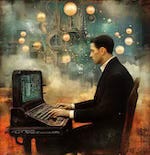The Algorithmic Universe
Time Portals and API Gateways: Coding our Way Through Timelines or How Computing Principles Parallel Timeline Mechanics
Recently, I was sitting outside a cafe with my husband and son. They were chatting about programming and other related tech subjects, as they often do. They are both professional tech nerds.
My ears were open, listening to all they said. Over the years, I’ve listened a lot. I’ve learned enough to make some interesting connections between their world and my own area of particular interest - metaphysics and Timeline Mechanics.
And that day, I had some huge aha moments!
You see, many Timeline Mechanic principles closely resemble many computing processes.
The deeper I’ve looked at this, the more convinced I am that computing mirrors organic processes. Or perhaps organic processes mirror computing processes.
Regardless, let’s explore the parallels. I’ve identified 11 of them, but there may be many more. By contemplating these, we Timeline Navigators may gain deeper insights into Timeline Mechanics.
1. Timeline Loops and Infinite Loops
"One of my most productive days was throwing away 1000 lines of code," - Ken Thompson, co-creator of UNIX.
In computing, an infinite loop is when a sequence of instructions is repeated endlessly. It causes the program to become stuck.
Timeline Loops is when individuals find themselves repeating patterns or reliving experiences that seem impossible to break free from.
Both processes require eliminating the underlying loop to move forward.
Breaking free from Timeline Loops often involves shedding outdated beliefs, habits, or emotional baggage.
In other words:
We can debug and reprogram our minds to exit cyclical Timelines.
2. Time Pockets and Memory Caches
"The trouble with programmers is that you can never tell what a programmer is doing until it’s too late," - Seymour Cray, pioneer in supercomputing.
Time Pockets are moments detached from the usual flow of time.
They are analogous to memory caches in computing.
A cache stores frequently accessed data for quick retrieval.
Time Pockets house memories or emotions repeatedly revisited.
These cached moments may help give us insights or familiar comfort. But they can also be problematic when they trap us in unprocessed emotions or beliefs.
Time Pockets, like caches, are often unnoticed until they disrupt our flow.
In other words:
Identifying Time Pockets and clearing the “cache” allows for smoother Timeline Navigation.
3. Time Vectors and Data Streams
"Programs must be written for people to read, and only incidentally for machines to execute," - Harold Abelson.
Time Vectors represent directionality within Timelines.
They resemble data streams in computing.
Data streams involve continuous input and output, processing information in real-time.
Time Vectors guide the flow of experiences, shaping how events unfold based on past inputs.
Similarly, our Time Vectors are written by our intentions, desires, and beliefs, guiding the flow of our lives.
In other words:
We can purposefully shift the data stream of our existence toward desired outcomes.
4. Parallel Timelines and Multithreading
"Beware of bugs in the above code; I have only proved it correct, not tried it," - Donald Knuth.
The concept of Parallel Timelines states that multiple versions of reality exist simultaneously.
This can be compared to multithreading in computing.
Multithreading is when multiple threads run concurrently within a program.
Just as threads can interact, merge, or run independently, Parallel Timelines can intersect or diverge.
They do this based on resonating or resisting energetic frequencies.
Parallel processes are unpredictable.
In other words:
Navigating Parallel Timelines requires awareness and caution to prevent unintended entanglements.
5. Multiple Timelines and Virtual Machines
"Any sufficiently advanced technology is indistinguishable from magic," - Arthur C. Clarke.
Multiple Timelines resemble virtual machines (VMs) in computing.
VMs allow different operating systems to run on a single physical machine.
VMs are isolated but can share resources.
This is similar to how Multiple Timelines operate independently, yet they influence each other through a shared system.
In other words:
Each Timeline has its own set of rules and potentialities, but is not separate from any other Timeline.
6. Timeline Healing and System Recovery
"If debugging is the process of removing bugs, then programming must be the process of putting them in," - Edsger Dijkstra.
Timeline Healing is the process of addressing past trauma.
This mirrors system recovery in computing.
System recovery is when corrupted data is repaired or restored to a previous, functional state.
This recovery process often involves returning to the last known "good" configuration.
This is similar to energetic realignment or remembering Core Being.
In other words:
Timeline Healing involves resolving the root causes of energetic disruptions to restore an original state of balance and functioning.
7. Timeline Access and User Permissions
"It’s not that I’m so smart; it’s just that I stay with problems longer," - Albert Einstein.
Timeline Access is akin to gaining user permissions in computing.
Systems restrict access to sensitive data based on permissions.
Similarly, our ability to access certain Timelines depends on our frequency, readiness, and intention. We must have the keys.
These keys may be found through practices such as meditation, visualization, or energy work.
In other words:
Permission to navigate to different Timelines is earned through consistent work on our inner state, unlocking pathways previously hidden or restricted.
8. Timeline Portals and API Gateways
"You can’t manage what you can’t measure," - Peter Drucker.
Timeline Portals are entry points into different realities.
They function similarly to API Gateways in software architecture.
APIs (Application Programming Interfaces) act as intermediaries that allow different software components to communicate.
Timeline Portals serve as gateways between different Timelines.
In other words:
Knowing how to locate and use Timeline Portals allows us to access specific Timelines.
9. Timeline Nodal Points and Network Routers
"The function of good software is to make the complex appear simple," said Grady Booch.
Timeline Nodal Points function like network routers.
They direct traffic between different Timelines based on the user's intention and frequency.
Routers manage data flow between devices on a network, ensuring information reaches the correct destination.
Similarly, Timeline Nodal Points ensure our energy flows toward Resonant Timelines.
In other words:
By adjusting our frequency, and harnessing Timeline Nodal Points, we can route ourselves toward more harmonious and fulfilling experiences.
10. Timeline Frequency Bridges and Cross-Platform Integration
"The real breakthrough moments come when we connect seemingly disparate ideas, technologies, or cultures and create something new and transformative." – Tim Berners-Lee.
Frequency Bridges between Timelines resemble cross-platform integration in computing.
These bridges allow for the exchange of information, energy, or experiences between Timelines.
They also facilitate Timeline Jumps and Shifts.
In other words:
We can build and use pathways that connect Timelines for our own purposes.
11. Timeline Sculpting and Machine Learning
“Algorithms are everywhere," - Eric Schmidt, former CEO of Google.
Timeline Sculpting is the intentional shaping of our memories and imagination.
It parallels machine learning algorithms that learn from data and adapt outputs accordingly.
Both processes involve input (thoughts, beliefs) that generate outcomes, which are then refined through feedback loops.
In other words:
We can optimize our thoughts to support our desired outcomes.
Final words
By understanding these parallels, we can see our temporal self as a program with malleable code. We can bring our conscious awareness to the task of debugging, rewriting, and optimizing ourselves.
And so we Navigate Timelines with the precision of top programmers and the creativity of true visionaries.
ps. As we were sitting outside the cafe, and I was listening to my guys, some people walked by. I heard only this phrase, “Parallel Processes.”







My background is in technology and I have certainly come to recognize it as a mirror.
Amazing revelations here!
As we explore more about how AI works, comparisons like this one become more valuable. I learned a lot about computer programming from your post. Thank you!